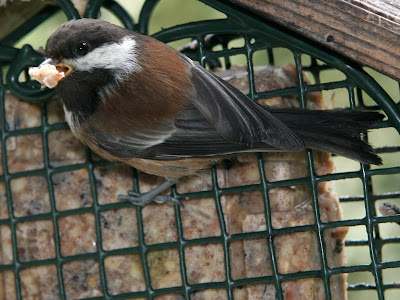For the Birds: Tree-huggers Supreme - the Chestnut-backed Chickadee
Tuesday, May 31, 2022
Photos by Craig Kerns
Most everyone in this area knows our endearing Black-capped Chickadees, but not everyone has the tree-lover Chestnut-backed Chickadees.
These noisy ambitious and acrobatic chickadees prefer the wet darker forests but will readily come to nearby feeders.
Chestnut-backed Chickadees have chestnut coloring on their backs and under their wings.
Their heads are dark brown, not black like the Blacked-capped Chickadees.
Their song is a little buzzier than black-capped. Some locals say they have a Scottish burr to their calls.
Did you know these handsome chickadees only live in the Pacific Northwest (northern California into lower Alaska)?
I didn’t. Maybe their coloration evolved to enhance their survivorship in their treeland habitats.
 |
| Chestnut-backed finding larvae in flowers |
People with tall evergreens in their yards will have these delightful denizens.
These chickadees are cavity nesters meaning they need dead trees, or trees with dead limbs where they make their own holes in these softer spots.
The male makes the hole, or uses an old woodpecker nest hole, and if the female approves, she accepts vegetation offered by the male.
 |
| Chestnut-backed using fur for its nest |
Nesting period is generally 18-21 day, and egg count can vary from 1 to usually about 6.
Both parents feed their young.
Chestnut-backed Chickadees will often arrive at a feeder in groups, unlike Black-capped Chickadees which have a hierarchical rule of one-at-a-time at a feeder.
 |
| Chestnut-backed Chickadees eat suet all year long |
Currently they are de-bugging my crabapple tree.
Being cavity nesters, they will often use a nesting box.
They like seasoned wood, so put the box up by early January. They will find it while travelling in their mixed-species winter groups.
Chestnut-backed Chickadees eat lots of bugs, especially larva, and will come to suet.
In the fall they also eat blackberries and other small fruits. They like seeds and will eat shelled peanuts.
Logging is reducing their numbers, so keep as many of your trees as you can.





0 comments:
Post a Comment